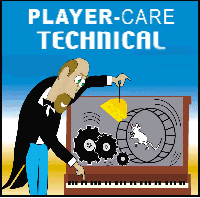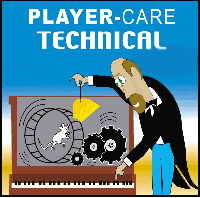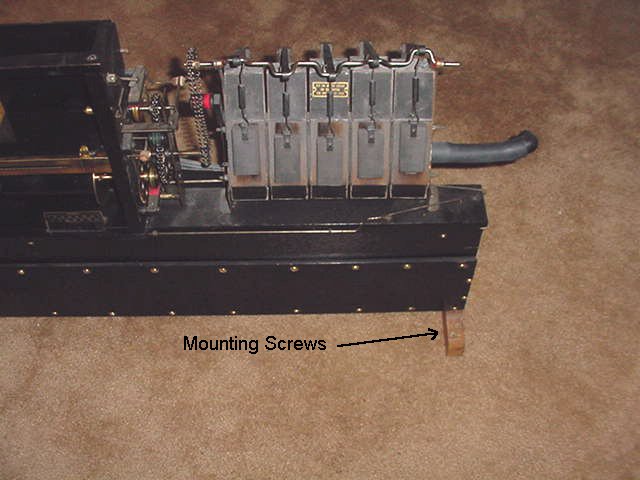
|

|

|

|

|

|
| Home | Manuals | Supplies | Search | Consult | Contact | Testing | Service |
Parts/Supplies (click) Technical Manuals .. (click here) Test your 'Player'.. (click here)


"Simplex Won't Play" |
|
Curtis writes:
Thanks Curtis: The next test, is to listen for the action of the valve itself. With the trackerbar covered with tape, and while pumping the pedals, poke a hole in the tape to allow one note to 'play'. Even if the note does not play, if the pouch is good, and if you listen carefully, you can hear the valve change state as you cover and uncover the hole. Typically, if you can hear the valve change state, then the pouch is at least operating - even if it has a small rip or hole. The only problem is, a pouch that is not 100% air-tight usually doesn't have enough force (when activated) to lift the valve all the way to the "on" position. And, that being the case, lots of vacuum will leak out (or more accurately - the atmosphere will leak in) through the half-opened valve - creating a serious vacuum leak. It only takes a few poorly operating valves to reduce the efficiency of a player system to below 50% - at which point it basically stops working, regardless of how fast you pump the pedals. To help people determine the basic condition of the Stack - which houses the valves and striker pneumatics (or in your case the block valve/pneumatics), go to the Testing the Player page at: https://www.player-care.com/test_me.html Also check out the page called "Simplex Problems" at: https://www.player-care.com/simplex_problems.html Hope this helps.....
Curtis write again:
Thanks again Curtis: Remove the wooden pieces of the piano that cover the player mechanism. (front board, music desk, fallboard) Once the player stack is 'exposed', you'll see the upper section (see simplex3.jpg) It's held in place by four large screws (two on each side) which are located at the base of the action mounts (see simplex1.jpg). Also, disconnect the two control rods (at the right end of the action) and the air motor hose. Also disconnect the spoolbox bracket between the spoolbox and the plate. Lastly, disconnect the large vacuum supply hose leading to the stack (left hand side - accessed from the lower half of the piano). Then lift the action out of the piano.
 
Now remove all 26 perimeter screws. Remove the valve cover. Now you can see the 176 screws that hold valve blocks to the stack. They are in pairs. Remove a set at the extreme left or right of the stack to loosen a block. Be sure to loosen the rod that goes between the block and the flange finger, and move it out of the way. Now you should be able to remove the block. Once it's in hand, get to a very bright light and look inside of the rectangular hole where the block mounts to the stack. Inside of that hole you should be able to see the pouch. By blowing air into the third larger of the three holes (still looking at the mounting surface) you should see the pouch inflate, and you may be able to see if it has any holes or rips. By putting a tight-fitting hoses over the pouch hole and blowing in, you should be able to hear any air that is escaping from the pouch/pouch well. Mind you, it should be air-tight. Whether or not you use this information, I will use this email and the previous email to create another web page at Player-Care..... (This is how new pages get created....) For information about rebuilding the Simplex pneumatic blocks, by Bruce Newman, watch his YouTube video at: Rebuilding Simplex Player Piano Unit Pneumatics
Musically,
John A. Tuttle |
|
Since "Player-Care" is an internet business, I prefer that we correspond via E-Mail (click here to fill out the 'Request Form'). However, if I'm not in the middle of some other activity, you can reach me at 732-840-8787. But please understand that during the hours from 8AM-5PM EST (Mon-Sat), I'm generally quite busy. So, I probably won't answer the phone. If you get the answering machine, please leave a detailed message stating the reason for your call. Also, repeat your name and phone number clearly and distinctly. By necessity, I prioritize everything in my life. And, if you call and just leave your name and number, and ask me to call you back, it might be a day or two before I return your call. Why? Because I don't know why you want me to call and I might not be prepared to assist you in an effective and efficient manner. If you leave me an E-Mail address (which I prefer), spell it out phonetically. The more you do to help me, the more I can help you in return. Don't rush. You have four minutes to record your message. |
|
407 19th Ave, Brick, NJ, 08724 Phone Number 732-840-8787 (Voicemail Only, No Texts) |
